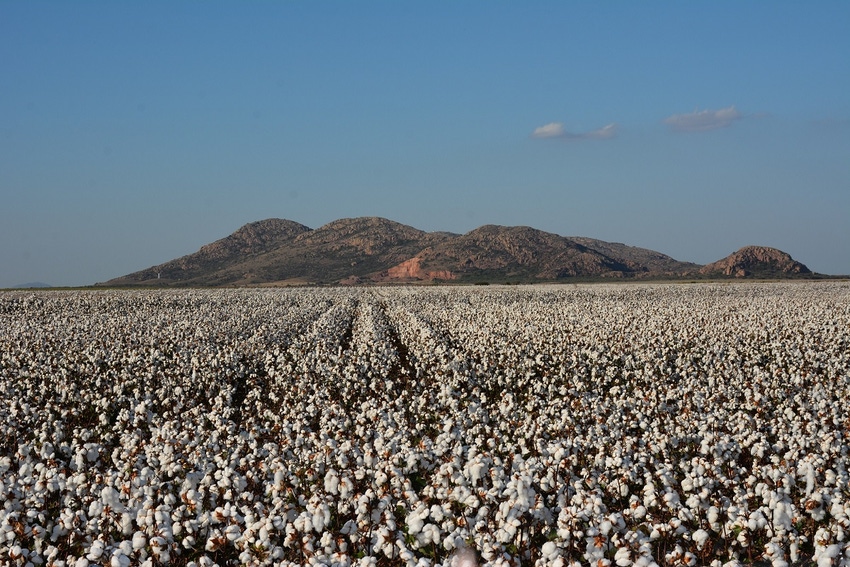
As most Southwest cotton farmers head into the home stretch to make the 2017 crop, a progress report seems appropriate. Southwest Farm Press contacted cotton specialists this week in Texas and Oklahoma to get their perspectives on crop prospects.
We asked Seth Byrd, Texas AgriLife Extension cotton specialist at the Research and Extension Center in Lubbock; Randy Boman, Oklahoma State University Extension State Cotton Lead, Altus, Oklahoma; and Gaylon Morgan, Texas AgriLife Extension State Cotton Specialist, College Station, for an assessment of conditions. We will provide these updates over the next few days. Here’s Randy Boman’s update.
We asked:
FP—What effect has recent weather had on development of the crop—good and bad?
Boman— We had a very good year for all cotton in 2016, 1,021 pounds per acre, which was a record for the state. We’ve had good rains in places over the last week or so. Oklahoma’s cotton crop, overall, is in pretty good shape. Cotton is grown mostly in the area west of Interstate 44 and south of Interstate 40, and looks promising. The area has received, depending on the location, 1.1, 1.3 and as much as 2.61 inches of rain. I think Tillman County is set up to for a good harvest. So is Jackson County, and Kiowa County cotton looks excellent. The area to the Northwest, around Elk City, needs a rain. That area has been running a deficit pretty much all year.
Most irrigated cotton will probably not be quite as good as it was last year. Some irrigated cotton was planted later than normal due to weather issues, and some fields had to be replanted. .
Based on Oklahoma Boll Weevil Eradication Organization numbers, we’re looking at a big acreage increase, 550,000 acres compared to about 305,000 last year. Tillman County is increasing from 75,000 acres to 135,000; Jackson is up from 98,000 to 140,000; Kiowa County farmers planted 45,000, up from 12,000 last year, a huge increase. Harmon is up from 26,000 in 2016 to 40,000 this season.
In the Carnegie area, Caddo County is doubling acreage, from 12,000 to 24,000; and Custer is at 10,000, up from 4,000 last year. That Carnegie area will be up by some 20,000 acres over last year.
We feel pretty upbeat about the 2017 cotton crop. I think we will gin as big a crop as we did last year if the weather cooperates.
FP—Some areas have had heavy rain. Are you seeing weather damage?
Boman —Moisture issues have been mixed. Some dryland cotton in Tillman, Jackson, and Kiowa counties went in behind wheat. It’s probably wildcat cotton, and it did not get good rain after planting, so there were some stand establishment issues. Dryland cotton otherwise looks fair to good. Continued rainfall would be a blessing, as we have some very good dryland cotton.
FP—How much abandonment have we seen or are likely to see?
Boman —In discussions with John Henderson, with the Boll Weevil Eradication Organization, we estimate perhaps somewhere around 10 percent abandonment. That’s less than the state’s long-term average of nearly 22 percent. We’ve had only a 5 percent abandonment rate the last two years, but we’ve had stellar fall weather.
FP—Have recent wet conditions had any effect on disease? Any surprises?
Boman —We have not had a lot of issues with disease pressure and haven’t seen Bacterial blight this year. A lot of farmers planted resistant varieties after last year’s problem. Some reported stand establishment issues due to low seedling vigor with some of these varieties, however.
FP—How has introduction of the new technology gone? Are you seeing much off-target damage? Are many growers using the Flag the Technology Mobile App?
Boman —I have not had a single call to my office about off-target or misapplication of the new auxin herbicide materials in cotton. These are new tools and we have a significant acreage increase, 550,000, up from 305,000 last year and 215,000 in 2015. Growers who are using the Flag the Technology Mobile app are those using mixed technologies. Most planted a single trait and are not as concerned. We expected about 60,000 acres of Enlist cotton to be planted in the state, with most up near Carnegie, where they typically see more 2, 4-D applied to grain crops during the summer months.
Farmers need to be aware of this new technology, be good stewards of their herbicides and not risk losing it.
Next up, Gaylon Morgan talks Central and South Texas cotton conditions.
About the Author(s)
You May Also Like






